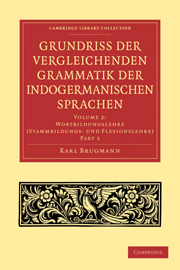Book contents
- Frontmatter
- Vorwort
- Contents
- Verbesserungen und Nachträge
- Wortbildungslehre (Stammbildungs- und Flexionslehre)
- Nominale (und pronominale) Stammbildung und Flexion
- Nominale Zusammensetzung (Nominalcomposita)
- Reduplicierte Nominalbildungen
- Nomina mit stammbildenden Suffixen
- Nomina ohne stammbildende Suffixe (Wurzelnomina)
Nominale Zusammensetzung (Nominalcomposita)
Published online by Cambridge University Press: 10 November 2010
- Frontmatter
- Vorwort
- Contents
- Verbesserungen und Nachträge
- Wortbildungslehre (Stammbildungs- und Flexionslehre)
- Nominale (und pronominale) Stammbildung und Flexion
- Nominale Zusammensetzung (Nominalcomposita)
- Reduplicierte Nominalbildungen
- Nomina mit stammbildenden Suffixen
- Nomina ohne stammbildende Suffixe (Wurzelnomina)
Summary
Form der Zusaminensetzungen
10. Wir unterscheiden vier Kategorien von Compositen:
I. solche, in denen das erste Glied der Stamm eines declinierten Nomens oder Pronomens ist, z. B. gr. μονο-γενής neben μόνο-ς;
II. solche, in denen das erste Glied ein Wort ist, das in keiner unsrer Forschung zugänglichen Periode der indogerm. Sprachgeschichte als flectierbares Wort vorkommt und nur in Compositis auftritt, z. B. gr. ἄ-βατος;
III. solche, in denen das erste Glied ein altüberkommenes adverbiales Wort (mit oder ohne Casusendung) ist, das auch ausserhalb der Composition gebraucht wurde, z. B. gr. ἐπί-ϑετος neben ἔπι-ἐπὶ;
IV. solche, in denen der erste Theil entweder ein Casus ist, der als lebendiges Glied eines Casussystems die Zusammensetzung mit dem andern Theil einging, oder ein Adverbium, das erst in einzelsprachlicher Entwicklungszeit zum Adverb geworden war und als solches die compositionelle Verbindung mit dem andern Wort erfuhr, z. B. gr. Διόσ-ϰουροι und παν-αίολος.
Diese Eintheilung statuiert keine principiellen Unterschiede. Sie soil zunächst nur die Übersicht erleichtern. Die verschiedenen Classen schwankten im Verlauf der Sprachgeschichte vielfach in einander, und es kamen zum Theil Neubildungen auf, die sich von dem alten Bildungshabitus der betreffenden Classe weit entfernten.
Die Classen I imd IV stellt man oft als ‘echte’ und ‘unechte’ Composita einander gegenüber. Letztere heissen auch Juxtaposita.
- Type
- Chapter
- Information
- Publisher: Cambridge University PressPrint publication year: 2010First published in: 1892



